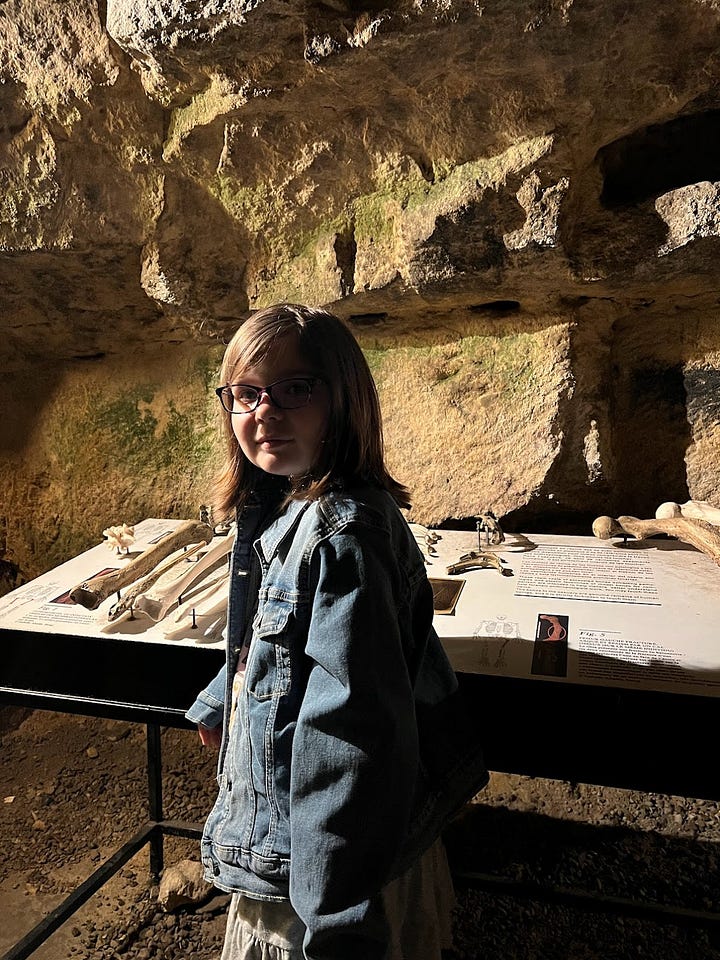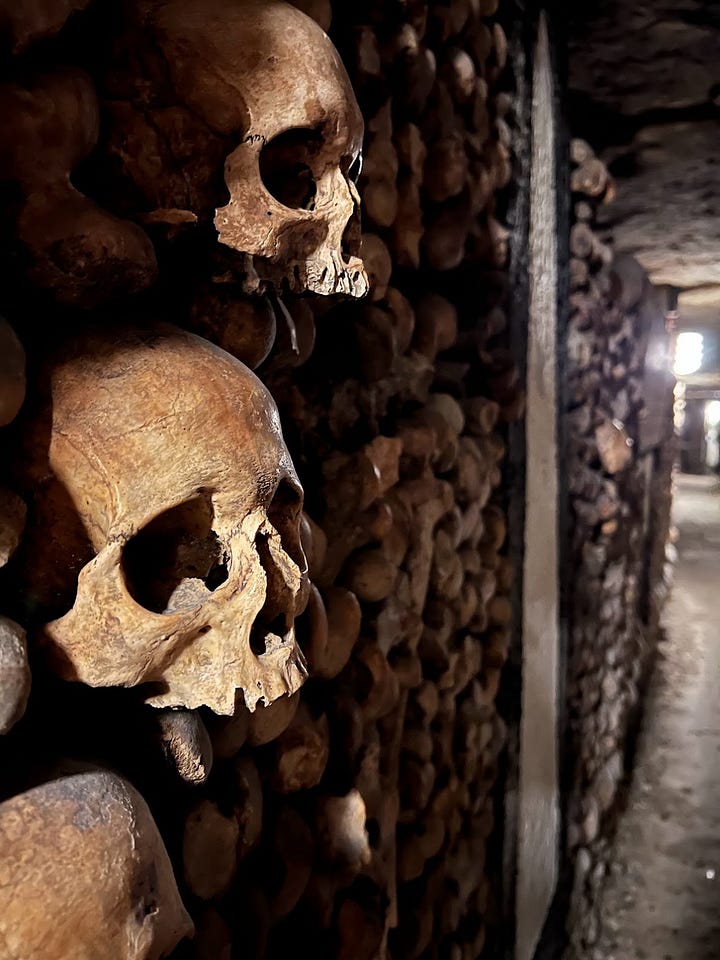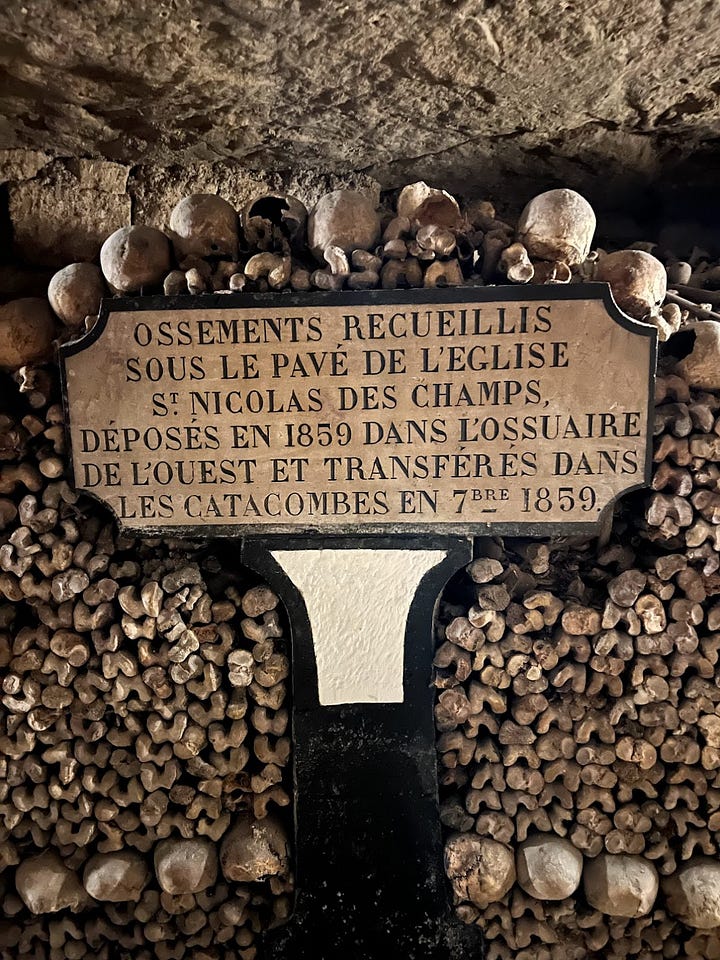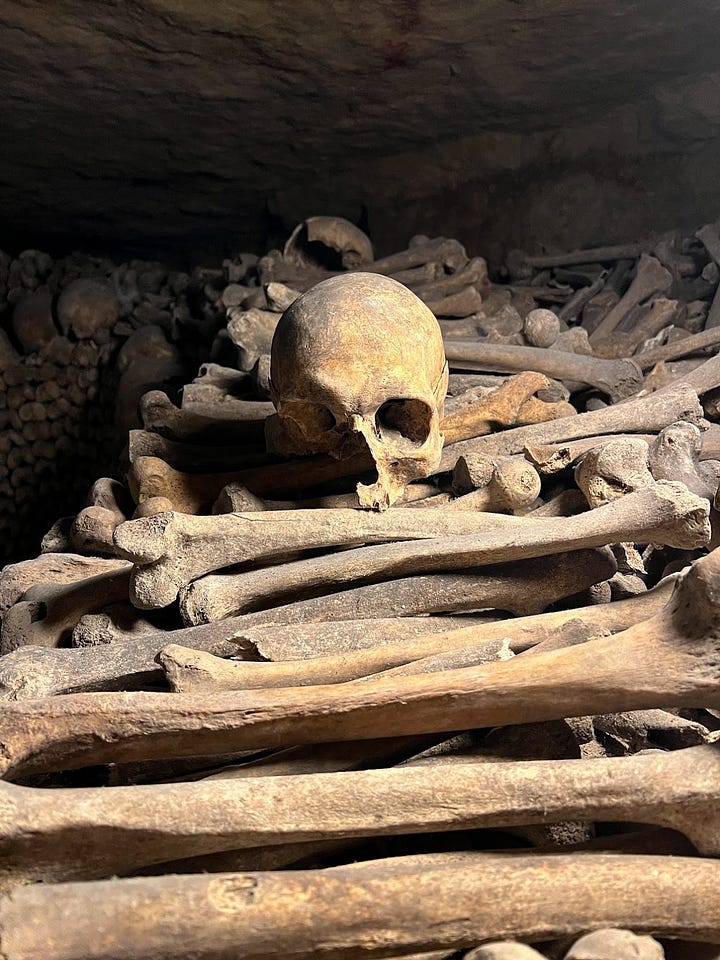Happy Spooky Season! My family went to Europe this year and all my 10-year-old wanted to see was “death.” She’s also a cheerleader who loves Hello Kitty merch. So…love of death comes in all shapes and sizes?
Therefore, we spent an afternoon in Paris exploring the Catacombs. To round out this deathly newsletter, I’ll recommend reading A Cloud of Outrageous Blue by Vesper Stamper, which has a most excellent plague scene. Finally, if you have the unfortunate task of having to teach something on Halloween, might I recommend a Black Death Day? It’s usually a hit with my macabre students.
A place to explore: The Catacombs of Paris




The story behind these catacombs begins in the 12th century when Parisian miners began extracting rocks and such from underground quarries. This practice continued for a few hundred years and by the 1500s, you could apparently walk “leagues”1 under Paris through the tunnels formed from empty quarries.
In the 1770s, sections of Paris started to collapse into the empty spaces below the city. While he still had his head attached, King Louis XVI organized for the underground tunnels to be mapped out and dealt with.
At the same time, cemeteries were overcrowded and churches all took on the stench of rotting flesh. It didn’t take a genius to realize that one problem could solve another. The tunnels were propped up and bones were dumped inside.
It didn’t take a genius, but it did take some grave diggers, priests,2 and soap/candlestick makers.3 Then the Reign of Terror came along, and guillotine victims were thrown into the tunnels along with exhumed bones from graveyards.
When Napoleon Bonaparte arrived on the scene and declared that the Revolution was over, he also hired Hericart de Thury to deal with the messy and immoral situation in the underground tunnels.
This is when the catacombs went from a stinking disaster to a work of art. Piles of bones were formed into orderly and artistic stacks, still viewable today.
I wasn’t quite sure what I was supposed to feel, as my jetlagged family headed down the soggy steps and wandered through the mile-long trail lined with bones. Should I feel guilty that I paid to see the remains of actual humans as tourist entertainment? Should I feel amazed at the various moments of history, stretching back to the 12th century that made this experience possible? Should I reflect on the fact that in death, these bones represented the French Revolutionary ideals of “Liberté, égalité, fraternité” - here are the bones, of 6 million Parisians, with all distinctions of wealth and rank stripped away, after all? Or should I feel happy that I could provide my kids with the deathly experience that they had been hoping for?
I’m still not sure.
A book to read: A Cloud of Outrageous Blue by Vesper Stamper
As Parisians were just starting to mine those tunnels that would become the catacombs, they were also dying of the Black Death and doing a whole lot of praying.
All this is detailed in Vesper Stamper’s young adult novel, A Cloud of Outrageous Blue.
It’s the story of Edyth who finds herself working in a priory in the 14th century after her family falls apart. When the plague hits a nearby village, she is there to help the afflicted. The story weaves from historical fiction to magical realism as Edyth’s powers are explored. Stamper also includes her own full-color illustrations in the book, which add to the immersive read.
The book is a perfect antidote for the immoral lack of empathy that I felt while traipsing through the catacombs. Unlike my tourist experience, reading this book pulled at my heart. That’s what all great historical fiction does right? It makes the past actually come alive in a way that monuments and textbooks can’t quite do.
I read a couple of pages to my students as part of their lesson on the Black Death. A picture of those pages can be found on the Google Slides document below.
A lesson to teach: Primary and Secondary Sources on the Black Death
I’m sure you all teach your students about primary and secondary sources when the school year begins, possibly as part of a “history skills” intro to the class as I do. However, by Halloween, they’ve forgotten. Sorry - that’s just the cold, hard truth.
I help to jog their memory about both primary/secondary sources as well as fiction vs. non-fiction sources. Have you all seen that meme that’s been traveling around social media that defines nonfiction as learning through facts and fiction as learning through imagination? I love it.
Then, I’ll give my students some information on the Black Death. I read them a couple of pages of A Cloud of Outrageous Blue. I show them a two-minute clip from YouTube in which the rat from Disney’s Ratatouille explains that the Black Death was caused by a flea, not a rat (thus exonerating rats everywhere). Then they read a primary source from Italy. I have spaces under each paragraph wherein I tell my students to draw a picture of what they read. Students also look at a map, analyze a picture, listen to Edgar Allan Poe’s The Masque of the Red Death, and read a few paragraphs about how Jews were sometimes blamed for the Black Death. Students will remember this antisemitism months later when studying the rise of Hitler.
The lesson usually takes about two 50-minute class periods. Feel free to make your own copies of my Google Slides presentation, the readings/map/pictures, and the student chart where they record their thoughts on each source.
Welcome to my first footnote! I don’t know what a league was, and Wikipedia doesn’t really know either. Apparently is varies from place to place. Perhaps a mile? Or two? Or three? Also, how exciting is this footnote feature?!?
Priests followed the bones from the original graves to the tunnels, praying as they went.
All the fat and tissue that hadn’t yet decomposed was made into soap and candles. See Fight Club for more details.


